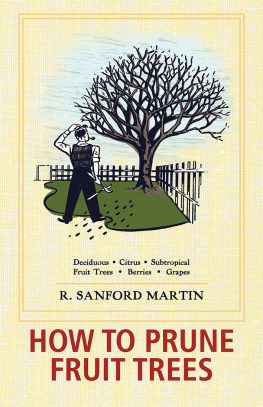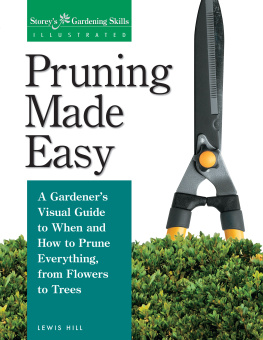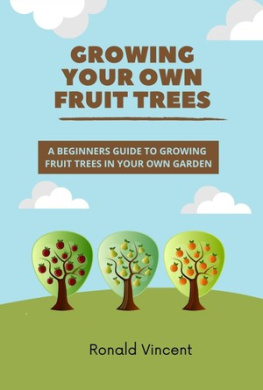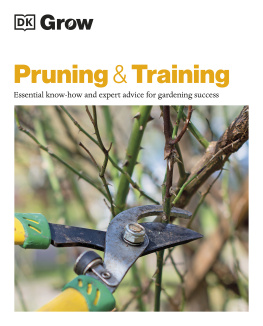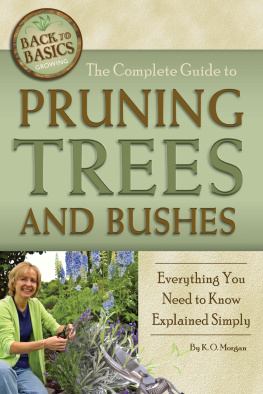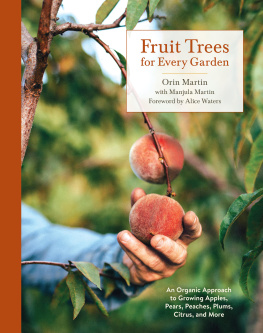
H OW TO PRUNE
FRUIT TREES

Copyright 1944
Additional material from Pruning Made Easy
by H. H. Thomas and edited by Christine Schultz:
Copyright 2013 Echo Point Books & Media
Published by Echo Point Books & Media
www.EchoPointBooks.com
ISBN: 978-1-62654-954-8
Cover design by Adrienne Nunez,
Echo Point Books & Media
Printed in the U. S. A.
FOREWORD

T HE subject covered in this book is here largely as a result of many requests from those who have used my first book, How to Prune Western Shrubs. I have hesitated in having this book printed because I was aware that this subject has been well covered many times by others, and in much greater detail.
Therefore, in publishing this book I have tried to make my instructions as simple as possible, to try to unmask the subject of Pruning Fruit Trees, and put it in its correct light, that is, a very simple procedure, providing one knows what he is pruning for. In each type of fruit tree discussed, I have attempted to bring out the main reason why that particular tree needs pruning, in as simple a manner as I knew. To one who understands how, where, and why a tree bears its fruit, pruning is an extremely simple job.
This book is not intended for the commercial orchardist in any way. In fact in some cases the procedure which I have recommended is quite contrary to general orchard practice. The owner of a few trees for home consumption alone is not concerned with picking costs, maximum trees per acre, and mechanical cultivation problems. In many homes the fruit trees are neglected because no experienced pruner is at hand at the time the pruning should be done, and again, the price paid to have one or two trees pruned is out of proportion to the amount of fruit harvested.
It has not been my intention to make expert pruners out of everyone owning a fruit tree, but I hope that I may help those who have the desire and time to care for their own trees, thereby eliminating much unnecessary neglect and destruction by incorrect treatment.
R. SANFORD MARTIN.
HOW TO PRUNE FRUIT TREES
ALMOND
Almonds and Peaches are of the same family, but the Almond develops more erect type of growth, so must be kept thinned out more carefully. The method of fruit production is also slightly different, so that heading back of the fruit-bearing wood is unnecessary as is the case with Peaches.
Pruning should be done during the winter months while the tree is dormant.
In some sections of the country there will be more die-back than in other areas. The first procedure is to remove any dead wood which has shown up during the past season. Second, cut out the least important of interfering or rubbing branches.
Fruit will be borne on an Almond tree on the one-year branches. That is, branches which grew during the last seasons growing period will produce fruit this summer.
Prune out the twigs which produced fruit the last summer, leaving one or two new shoots which should have grown from near the base of the last years fruiting-wood. Make the cut immediately above the upper shoot to be left. These shoots or twigs, which are left will be the best fruit producing wood. When this phase of the pruning is complete, the tree should have an even distribution of young branches all over the tree. If they are thicker in one portion of the tree top than another, do a little further thinning until the distribution of one-year branches is even.
Do not be concerned about your Almond tree growing too tall, as the ripe nuts may be knocked from the branches with long poles without damage to the tree.
Because of the brittle characteristic of Almond wood, it is desirable to encourage the growth to be erect, with the center of the tree well filled in.
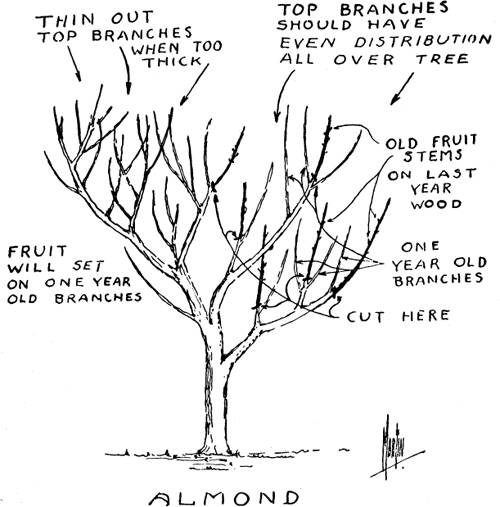
APPLES
There is no set type for the shape of a bearing Apple tree, because, depending upon variety, the younger trees will vary from growing erect and slender to open and spreading. Eventually as the tree matures, it will develop into a fine spreading type. Observe your particular tree and if it is of the narrow erect type, according to its initial growth, make your pruning cuts just above buds which are pointed away from the center of the tree. If your variety of Apple is of the spreading type make the cuts above buds pointed toward the center of the tree. The time for pruning is during the winter months.
All Apples produce their fruit on spurs, which are formed on the branches one year old or more, usually in the lower portion of these branches. These spurs are developed from the short lateral growths that vary in length from one to three inches. After they have definitely formed they can be recognized by their thick stubby appearance. The spurs produce blossoms and fruit year after year, and should be saved wherever possible.
When pruning the Apple tree, first cut out any dead or deceased branches, being careful to make cuts close to the main branch, without leaving any stub. This is very important because all apples are quite susceptible to rot, which can easily start in a stub which is left long enough to die back, rather than heal over with bark and new wood growth.
Second, cut away any interfering wood, or branches that are rubbing against one another, or that have come down too close to the ground and hinder cultivation.
Third, cut out sufficient of the last years branch growth to evenly space all branches, allowing even sunlight penetration throughout the tree top. In doing this cutting, be careful to leave all established fruit spurs and those small lateral bud developments that are to be future fruit spurs.

If the tree is making a normally rapid growth, especially a young tree, the new branch growth must be cut off just above the fruit spur buds. In the case of young trees, this will mean about two-thirds their length, as shown in the illustration.
Water sprouts or suckers should be cut out at any time that it is proven by their growth to be such. A sucker is a rapid growing shoot that comes from below ground, and they should be removed as soon as they appear, by digging down to their base and cutting them off very close to the root or trunk. Painting the cuts will help prevent rot from setting in. Water sprouts are above ground suckers and are recognized by their habit of growth, which is excessive in comparison with the rest of the branch growth of the tree. This growth is by nature, weak in structure and will not develop into suitable fruit producing wood, so cut it off clean and allow its sap to flow into more useful branches. These water sprouts, where allowed to grow will deprive the tree of valuable energy.
In the case of old trees, which have lost a main branch, or become one-sided, the water sprouts may be utilized to fill in vacant spaces, by heading them back, thereby forcing them to branch out and slow down their excessive soft growth.
Thinning the crop of fruit is frequently necessary with Apples, and this work should be done after the June drop has taken place. The June drop is a natural process with all fruit trees, in an effort by nature to adjust the crop to what the tree can bear. This period is apt to occur any time after the first of May, to July, and if in your opinion there still remains too much fruit for your trees to ripen, they may be hand thinned, leaving the remaining fruit evenly spaced throughout the trees branches.
Next page
